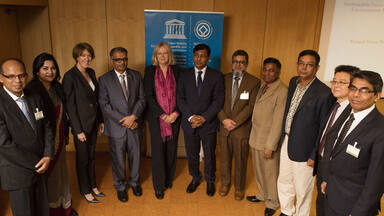World Heritage Centre and IUCN call for relocation of Rampal power plant, a serious threat to the Sundarbans
The Sundarbans in Bangladesh is part of the world’s largest mangrove forests, home to the famous Bengal Tiger and a hotspot for dolphins, turtles, and birds. Millions of people depend on this labyrinth of tidal rivers for food, homes, and flood protection.
The Sundarbans were inscribed on the UNESCO World Heritage List in 1997, and will celebrate its 20th anniversary next year. In March 2016, the World Heritage Centre and International Union for the Conservation of Nature (IUCN) conducted a reactive monitoring mission to assess the conservation of this iconic area. The mission was requested by the World Heritage Committee during its 2015 session in Bonn.
The mission was tasked with reviewing potential impacts from the construction of the Rampal power plant, assessing risks from climate change, and evaluating the overall management system of the Sundarbans, including provisions around shipping safety. The mission visited the site of the proposed Rampal power plant, as well as the locations of a 2015 cargo vessel accident and 2016 oil spill. It included meetings with key ministries, industry representatives, port authorities, a small number of researchers and local community members.
This week, the World Heritage Centre and IUCN released a report on the mission. The report concludes that the proposed Rampal power plant, a 1320 megawatt super thermal power plant located just 65 kilometers from the World Heritage property, poses a serious threat to the site. The mission team identified four key concerns related to the plant’s construction: pollution from coal ash by air, pollution from wastewater and waste ash, increased shipping and dredging, and the cumulative impact of industrial and related development infrastructure. The mission recommends that the Rampal power plant project be cancelled and relocated to a more suitable location.
The report also concluded that the freshwater flow into the Sundarbans has been drastically reduced, resulting in substantial increases in siltation and salinity that are threatening the overall balance of the ecosystem. It further found that the site lacks a clear and comprehensive assessment of the combined effects from increasing coastal development. The report recommends immediate action to secure adequate freshwater flow to the site, and calls for a new integrated management plan taking into account the carrying capacity of this fragile ecosystem that can secure a sustainable balance between socio-economic development and conservation.
The State Party of Bangladesh has been requested to provide a progress report to the World Heritage Centre by 1 December 2016, including a 1-page executive summary on the state of conservation of the property. It will be examined by the World Heritage Committee at its 41st session in 2017, in view of possible inscription on the List of World Heritage in Danger.
Read the full Report on the Mission to the Sundarbans World Heritage site here.
Decisions (1)
The World Heritage Committee,
- Having examined Document WHC-15/39.COM/7B,
- Recalling Decision 38 COM 7B.64, adopted at its 38th session (Doha, 2014),
- Notes that the Environmental Impact Assessment (EIA) for the dredging of the Pashur River, adjacent to the property, did not include a specific assessment of the potential impacts on the property’s Outstanding Universal Value (OUV), and requests the State Party to submit to the World Heritage Centre an assessment of potential impacts on OUV, in accordance with IUCN’s World Heritage Advice Note on Environmental Assessment, and to ensure activities are not conducted before the revised EIA is submitted to the World Heritage Centre and reviewed by IUCN;
- Reiterates its request to the State Party to undertake a comprehensive Strategic Environmental Assessment (SEA) in order to assess the indirect and cumulative impacts from the power plants and other developments in the vicinity of the property, including a specific assessment of potential impacts on its OUV;
- Also requests the State Party to provide further details on the mitigation measures taken for the power plant project, which should fully consider the findings of the SEA;
- Regrets that the ecological monitoring data for the property requested by the Committee in Decision 35 COM 7B.11 has not been provided, and urges the State Party to submit the results of the ecological monitoring programme for the property without delay, to the World Heritage Centre for review by IUCN, ensuring that the impact of climate change on the OUV is documented, as initially requested in Decision 33 COM 7B.12;
- Further requests the State Party to continue monitoring the effects of the December 2014 oil spill on the aquatic environment, and to take measures to prevent such accidents, drawing on the lessons learned so as to strengthen its oil spill preparedness and response capacity, in particular in view of the anticipated increases in river navigation related to the power plant developments upstream;
- Requests furthermore the State Party to invite a joint World Heritage Centre/IUCN Reactive Monitoring mission to the property to review the state of conservation of the property, and the potential impacts of the thermal power plant development and dredging of Pashur River;
- Requests moreover the State Party to submit to the World Heritage Centre, by 1 December 2016, an updated report, including a 1-page executive summary, on the state of conservation of the property and the implementation of the above, for examination by the World Heritage Committee at its 41st session in 2017.





